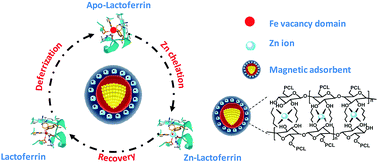Complexes of magnetic nanospheres with amphiprotic polymer–Zn systems for the selective isolation of lactoferrin†
Abstract
Amphiprotic polymer–Zn complex magnetic nanospheres, termed Fe3O4@PCL–CMC–Zn, are designed and prepared via a step-wise synthetic strategy. Hydrophobic polycaprolactone (PCL) is firstly coated onto the magnetic Fe3O4 nanospheres, and then hydrophilic carboxymethylcellulose (CMC) is grafted onto the hydrophobic PCL blocks via an esterification reaction, followed by finally chelating with Zn2+ ions. The homogeneous core–shell structure and fastened amphiprotic polymer layer provide the as-prepared Fe3O4@PCL–CMC–Zn magnetic nanospheres with improved protein binding behavior, and the chelated Zn2+ offers the nanospheres favorable adsorption selectivity towards apo-lactoferrin. The adsorption capacity of apo-lactoferrin is high, up to 615.3 mg g−1. The exploitation of FeCl3 as a stripping reagent not only provides efficient recovery of the adsorbed apo-lactoferrin, i.e. a recovery of 83.2%, but also achieves the restoration of the lactoferrin structure. The Fe3O4@PCL–CMC–Zn magnetic nanospheres are then employed as a sorbent for the selective isolation of lactoferrin from human colostrum samples, obtaining high-purity lactoferrin as demonstrated by SDS-PAGE and Q-TOF LC-MS assays.



 Please wait while we load your content...
Please wait while we load your content...